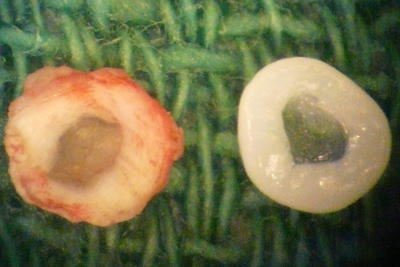摘要:科研人员报告说,植入大鼠体内的生物工程椎间盘有助于恢复脊椎的力学功能。每年美国人花费数十亿美元用于背部和颈部疼痛的治疗,这种疼痛是由于脊椎中的软骨盘的损伤造成的。尽管用机械植入物替代受损椎间盘的外科干预手段能减轻一些疼痛,但是许多植入物由于松弛、移位和磨损而失效。Lawrence J. Bonassar及其同事使用组织工程技术,利用绵羊细胞制造出了一种生物椎间盘,它是由胶原蛋白包围的胶状核心组成的。这组作者把这种椎间盘植入到了大鼠脊椎中,其中一些大鼠的尾部下的椎间盘被去除了。使用磁共振成像和CT扫描,这组作者验证了植入的椎间盘类似于原生的椎间盘,而且尺寸正确地符合原生椎间盘占据的空间。6个月后,这组作者报告说,这些椎间盘保持了正确的高度、产生了细胞外基质,并且融入了脊椎。此外,这种植入物的力学属性包括它对于应压力的响应类似于原生椎间盘。这组作者说,在进行进一步的研究后,组织改造的椎间盘植入物有可能帮助取代人们受损的椎间盘,为背部疼痛提供了一个可能的长期解决方案。
生物探索推荐英文原文报道:
In the Battle to Relieve Back Aches, Researchers Create Bioengineered Spinal Disc Implants
Every year, millions of people contend with lower back and neck discomfort. With intent to ease their pain, Cornell University engineers in Ithaca and doctors at the Weill Cornell Medical College in New York City have created a biologically based spinal implant that could someday spell relief for these countless sufferers.

Pictured: From left, a natural rat IVD compared with a tissue engineered IVD.
Lawrence Bonassar, Ph.D., associate professor of biomedical engineering and mechanical engineering, and Roger Härtl, M.D., associate professor of neurosurgery at Weill Cornell Medical College and chief of spinal surgery at NewYork-Presbyterian Hospital/Weill Cornell Medical Center, have created bioengineered spinal discs that have been successfully implanted and tested in animals.
The other scientists on the paper are Robby Bowles, Cornell Ph.D. '11, and Harry Gebhard, M.D., of Weill Cornell Medical College.
Their research will be published online Aug. 1, 2011 in the Proceedings of the National Academy of Sciences.
"We've engineered discs that have the same structural components and behave just like real discs," says Bonassar. "The hope is that this promising research will lead to engineered discs that we can implant into patients with damaged discs."
Each year, 40 percent to 60 percent of American adults suffer from chronic back or neck pain. For patients diagnosed with severe degenerative disc disease, or herniated discs, neurosurgeons perform surgery called discectomy -- removing the spinal disc -- followed by a fusion of the vertebrate bones to stabilize the spine. In spite of the surgery, the patient's back will likely not feel the same as before their injury.
"The surgery prevents pain, but often limits mobility, which may hinder someone who has an active lifestyle or even end the career of a professional athlete," says Härtl, who is also the team neurosurgeon for the New York Giants.
Human discs look something like a tire, with the outer part, called the annulus, made of a stiff material, and the inner circle, the nucleus, made of a gel-like substance that gets pressurized and bears weight.
Bonassar's lab, which focuses on the regeneration and analysis of musculoskeletal tissue, engineered artificial discs out of two polymers -- collagen, which wraps around the outside, and a hydrogel called alginate in the middle. They seeded the implants with cells that repopulate the structures with new tissue. Remarkably, as opposed to artificial implants today that degrade over time, the scientists are seeing that the implants get better as they mature in the body, due to the growth of the cells.
"Our implants have maintained 70 to 80 percent of initial disc height. In fact, the mechanical properties get better with time," says Bonassar.
The implants would treat a broad category of illness called degenerative disc disease -- a leading cause of disability worldwide. According to Härtl, an increasing number of patients need treatment or surgery from the degeneration of the intervertebral disc. A surgical procedure approved by the FDA in 2005 involves removing the disc completely and replacing it with an implant made of a combination of metal and plastic, with the aim of mimicking the normal movement of the lumbar and spine.
"Bone or metal or plastic implants are complicated structures which come with a mechanical risk of the structures moving around, or debris from the metal or plastic particles accumulating in the body from wear and tear," says Härtl.
From a biological perspective, the new discs could create a "huge advantage" over traditional implants because of how they integrate and mature with the vertebrae. This major surgery would become less invasive, safer and come with fewer long-term side effects, he says.
The scientists began collaborating on the project in 2006, first funded by an Ithaca-Weill seed grant. Since then, the project has moved into animal testing stages, and it has received several awards and accolades, including a $325,000 grant from Switzerland's AO Spine foundation and $100,000 in support from NFL Charities.







